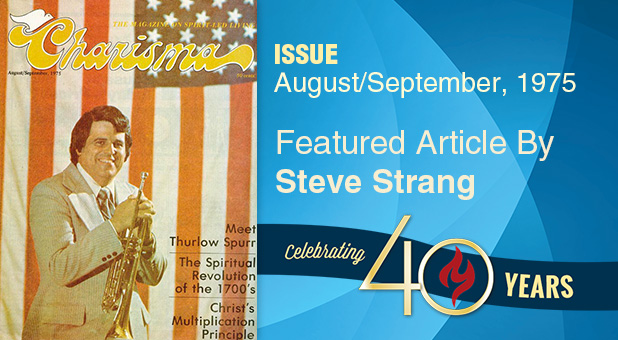The Spiritual Revolution That Shook the American Colonies
Editor’s note: This article was from the first issue of Charisma—August/September, 1975. That was the beginning of the bicentennial celebration, and this brand-new magazine wanted to tie in to what America was celebrating. Founding Editor Steve Strang wrote this article (as he wrote many of the early articles.) As history, it’s as thought-provoking today as when he wrote it. Do you agree with the arguments he gleaned from what various historians have written?
Fifty years before a Lexington minuteman fired the shot heard around the world, another revolution began that shook the American colonies.
It was a spiritual revolution which historians call the Great Awakening. It was marked by waves of religious enthusiasm as preachers like George Whitefield traveled the seacoast from Maine to Georgia, preaching that sinners should repent.
American history’s most famous sermon–“Sinners in the Hands of an Angry God:– was preached in 1741 by Jonathon Edwards at the height of the great revival.
History records that sinners repented by the hundreds. Taverns closed as whole towns repented. Often people were so moved by conviction they trembled and shrieked and fell to the ground moaning and begging God to forgive their sins.
Edwards writes about a young woman in his congregation who was so convicted of sin she declared that “it was pleasant to think of lying in the dust all the days of her life, mourning for sin.”
The preaching about turning from sin and the importance of salvation over the rituals of the state church in places like Massachusetts, was important in the light of history.
The result of the revival, which continued strong for 15 years and the effect of which continued for many more years, was to establish early in American life the importance of a man serving God as his conscience, not the state, dictated.
Thousands of newly converted people were forced by their churches to leave because their new convictions about the importance of salvation often threatened the existing ecclesiastical power structure. This fostered the growth of new churches like the Methodists and toppled any hope of one denomination becoming dominant and becoming the American state church.
Some historians consider the Great Awakening a major turning point in American history, yet it is frequently overlooked. While the national remembers its 200th anniversary this year and next, the Christian community can be inspired by remembering one of the greatest revivals on this continent.
The Great Awakening, besides being a major spiritual renewal, did much to foster a feeling of independence in the colonies and helped wipe out the class structure brought to the New World from Europe.
It also fostered education and several major universities like Dartmouth, Princeton and Brown, had their genesis in the revival. In addition, it stimulated missionary work among the Indians and slaves.
Historian Monroe Stearns wrote: “The Great Awakening’s essential purpose was to fulfill the royal law of love—to cause men to serve not themselves but one another and to join in an effort to improve society. The vision it revealed of the social good led to a challenge of the rulers of colonial society in America and into the discussion and activity that produced the movement for independence.
The Great Awakening has been, however, relegated to relatively minor role by most historians who view it as only emotional hysteria that they say has characterized revivals throughout our history.
The truth is, however, that despite emotionalism that characterized some of the Great Awakening from 1720 to 1760, it was the first great move of God on this continent and was the first of many revivals that have come to America since then.
To understand the importance of the revival and its impact on America, it’s important to understand the religious and social structure of the day.
Many of the early immigrants to America came because of religious oppression in Europe.
The French Huguenots were the first Protestants to flee to America. In 1562, more than half a century before the Pilgrims arrived at Plymouth Rock, a small group of Huguenots arrived in Florida in present day Jacksonville, hoping to escape the massacres of Charles IX of France. But within months, their settlement was destroyed by an agent of Philip II of Spain. Not one Huguenot survived.
In 1620, the English Separatists among them soon headed for Rhode Island with Roger Williams looking for religious freedom the Puritans did not give them.
The Pilgrims were followed in 1656 by the early Quakers who, being unwelcomed in New England, settled in New Jersey, then in 17682 in Pennsylvania.
By the early 1700’s, group after group of other Protestants seeking freedom from European intolerance began to arrive.
Of course, not every new settler in the new world came for religious liberty. Many came for economic and political opportunities not available to them in Europe. But many of the immigrants did come to worship God as they saw fit.
This desire for religious liberty and their deep faith in God was all that strengthened many of these early colonists to brave the perils of the American wilderness.
But after a few decades the original closeness to God that drove the early settlers to seek religious freedom was replaced by the coldness and rituals of the churches the settlers established.
This is what Theodorus Frelinghuysen found in 1720 when he was sent by the Dutch Reformed Church in the Netherlands to minister to Dutch settlers in New Jersey.
Frelinghuysen was a member of the Pietists who believed the power of the Holy Spirit could only be felt because it worked on the heart, not the brain. They put no emphasis on complicated church doctrines, but on having a “change of heart,” and becoming one with God.
Frelinghuysen preached that in order to be a member of the church and take communion, one must be born again. He caused quite a stir among the young and the poor who readily responded to his message.
The established, more prosperous members at first resisted, then began to become converted. Within five years his congregations had so increased and so many people had become converted, other ministers began inviting Frelinghuysen to preach at their churches, hoping for similar results.
Frelinghuysen greatly inspired a Presbyterian minister, Gilbert Tennent, and worked with him, breaking down denominational walls.
While Tennent and Frelinghuysen were preaching in New Jersey, Jonathon Edwards was causing a stir in New England with his sermons.
When he became minister in 1729 of the church of Northhampton, Mass., he found a generation of New Englanders who had grown up in spiritual confusion and who didn’t know how to be saved.
In addition, the churches of that area were controlled by the wealthy merchant class—the same people who controlled the government and who oppressed the people.
The Puritan Church had for many years preached salvation, but as the merchants began to seize control, more liberal ministers began to say salvation was not necessary for church membership.
Edwards resisted this trend, and preached faith in Christ was necessary for salvation. He began to see results.
In 1734, after five years at the church, he reported “a concern about the great things of religion began…to prevail abundantly in the town, till old and young, and from the highest to the lowest…Scarcely a person has been exempt, and the Spirit of God went on his saving influences…in a truly wonderful and astonishing manner.”
Word of the revival spread up and down the Connecticut River valley and by May, 1735, 25 towns had experienced similar awakenings.
The revival subsided until 1739 when a 24-year-old minister from England named George Whitefield began to preach in the New York area.
Whitefield had come to America in 1738 to establish an orphanage in Georgia.
Whitefield was such a magnificent speaker that many people came to hear him merely because of his speaking and acting ability.
He frequently preached on streets or in open fields.
Benjamin Franklin, who heard him in Philadelphia, estimated that Whitefield’s voice was so powerful 30,000 people could hear him at once, because he repeated key sentences four times—once in each direction.
Whitefield was so eloquent at raising money for his orphanage, that Franklin wrote he left his purse home on purpose when he went to hear him. Still, he had in his pocket several pieces of copper, several silver dollars and five pieces of gold.
“As he proceeded,” Franklin wrote, “I began to soften and concluded to give him the copper. Another stroke of his oratory made me ashamed of that, and determined me to give him the silver; and he finished so admirably, that I emptied my pocket wholly into the collection dish, gold and all.”
The Great Awakening was not without its problems, however.
Often when people felt convicted of their sins, they thrashed about on the floor, moaning and shrieking. Emotionalism was so widespread that it turned off many who had not been touched in their hearts with the Gospel message.
Rev. Jonathan Parsons of Lyme, Conn. wrote that some converts acted as if “the joints of their limbs were loosed and their knees smote one another…Several stout ones fell as though a cannon had been discharged and a ball had made its way through their hearts.”
One lady, Sarah Sparhawk, of Marlboro, Mass., was “like one deprived of her reason” and “was brought home (from church) by some young men. She often lay there crying out, screaming and striving much in her fits for an hour or two.”
Trances, visions, and something called “the jerks” became commonplace.
The opposers of the revival were led by Charles Chauncy, pastor of the old First Church in Boston. He objected to the “preaching of terror” and the “bodily effects.” He attacked the whole movement as a dangerous explosion of emotion.
Edwards saw the extremes of the revival, but still considered the Awakening a “surprising work of God,” and stedfastly defended it. He said the excesses of emotion were “enthusiastic delusions” or “impressions upon the imagination.”
He thought, however, that to oppose the revival as some ministers did, was evil. The “prevailing prejudice against religious affections at this day, in this land” was caused by none other than Satan, Edwards wrote.
He warned the critics of the revival that “for persons to despise and cry down all religious affections, is the way to shut all religion out of their own hearts, and to make thorough work in ruining their own souls.”
There were other great preachers in the revival. John Wesley, father of Methodism, was one. He preached in Georgia a number of years, and had an impact on the life of George Whitefield. But mostly Wesley’s influence was limited to England where a similar revival was taking place.
Samuel Davies, a Presbyterian, spread the revival to Virginia in 1748 where he had to get a license from the governor to preach.
The Anglican clergy opposed this non-Anglican in Virginia and took him to court saying he had no right to preach. The issue went to London in 1753 for a verdict and Davies won in 1755. It set a precedent for religious freedom in the colonies.
As the Great Awakening began to subside people like Davies continued to spread it until the 1750’s.
The Awakening had a long-run effect on education, social and moral structure of America for many years. But its main impact—and this should never be forgotten—was spiritual.
Men’s lives were changed when they encountered a personal faith in Jesus Christ. Despite the emotionalism that accompanied the movement, many new converts were made, and these converts had a different way of living.
Jonathon Parsons wrote of the new converts that “bitterness and wrath, and anger, and clamor, and evil-speaking seemed to be put away from them, with all malice…Rough and haughty minds became peaceful, gentle, and easy to be entreated… Their faith worked on love, and discovered itself in acts of piety towards God, charity and righteousness toward men and sobriety toward themselves.
That’s what true revival is all about.




























































